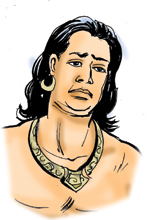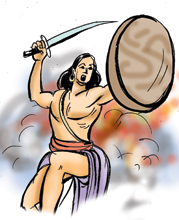1. Time passed. The elder prince was 16 years of age. Venerable Veedagama Thera, got down the prince. The army chiefs were also asked to come to the temple. By this time, the clergy too had lost confidence in Alakeshwara, mainly because he did not belong to the line of rightful kings. The venerable Thera introduced the prince to the army chiefs. They were delighted to meet him. Here they decided to push Alakeshwara out of power and make this prince the king. All plans towards this end were begun.
2. In the battle against the Chinese, Alakeshwara had helped earlier. The Chinese accepted him as the King of Lanka. The Portuguese writer 'Kuto' also proved it. However, when in China, Veera Alakeshwara too had accepted the prince as the rightful heir to the throne. But the very day he landed in the country, he got this prince killed.
3. Alakeshwara, once again became the ruler and ruled the country for 16 years. After his death there was no legal heir to succeed him. In some texts, it is said that a Buddhist priest carried on the administration. Some others say, that the second prince who was in hiding was brought and kept on the throne. From all this, it is evident that even Vijayabahu IV of Dambadeniya, remained a prisoner, in the hands of the Chinese.
4. The historical events of this period are shrouded in mystery and quite complicated. For a period of nearly 100 years, facts are all mixed up and confused. Some accounts are quite contrary to others. This is why historians have put forward different theories. In a book written during the period of Parakramabahu VI, there is a description of his lineage. That is to say that Parakramabahu VI was a son of Queen Sunetradevi who was the wife of Prince Jayakahalena.
5. If so, he is the grandson of Prince Parakramabahu, who was Savulu Vijayabahu's son. Savulu Vijayabahu is the fifth to go by that name. His son Parakramabahu is the one who ruled the country, from Dedigama. Another scholar says that Jayamahalena was the grandfather of Parakramabahu. However, he is supposed to belong to the family, that came after Parakramabahu V.
6. In this context, there is yet another theory that is put
forward. That is to say, that Parakramabahu VI was the son of Jayapala, and the mother belonged to a Kalinga dynasty. As mentioned earlier, Savulu line was connected to the Javaka line of kings. They are also known as Kalingas. Therefore Parakramabahu VI, belongs either to the Magha or Chandrabhanu line of kings.
7. The facts relating to this prince's accession to power are quite extraordinary. Whatever that may be, he was a clever ruler. He was the first king of the Kingdom of Kotte. After King Parakramabahu II, he is the only ruler, who could unify the entire country and bring it under one rule. He thus became the sole ruler of the country. The period of rule, of King Parakramabau VI is the last golden period in our history. He was successful in ruling the areas of Vanni and even Jaffna.
8. King Parakramabahu VI
suppressed the revolts in Malayarata. The chiefs of Vanni who wielded power there, were defeated by this king. To conquer Jaffna, he sent his adopted son, Prince Sapumal. This prince, conquered Jaffna, by defeating the king there. He brought entire Jaffna under the control of the King of Kotte. |



